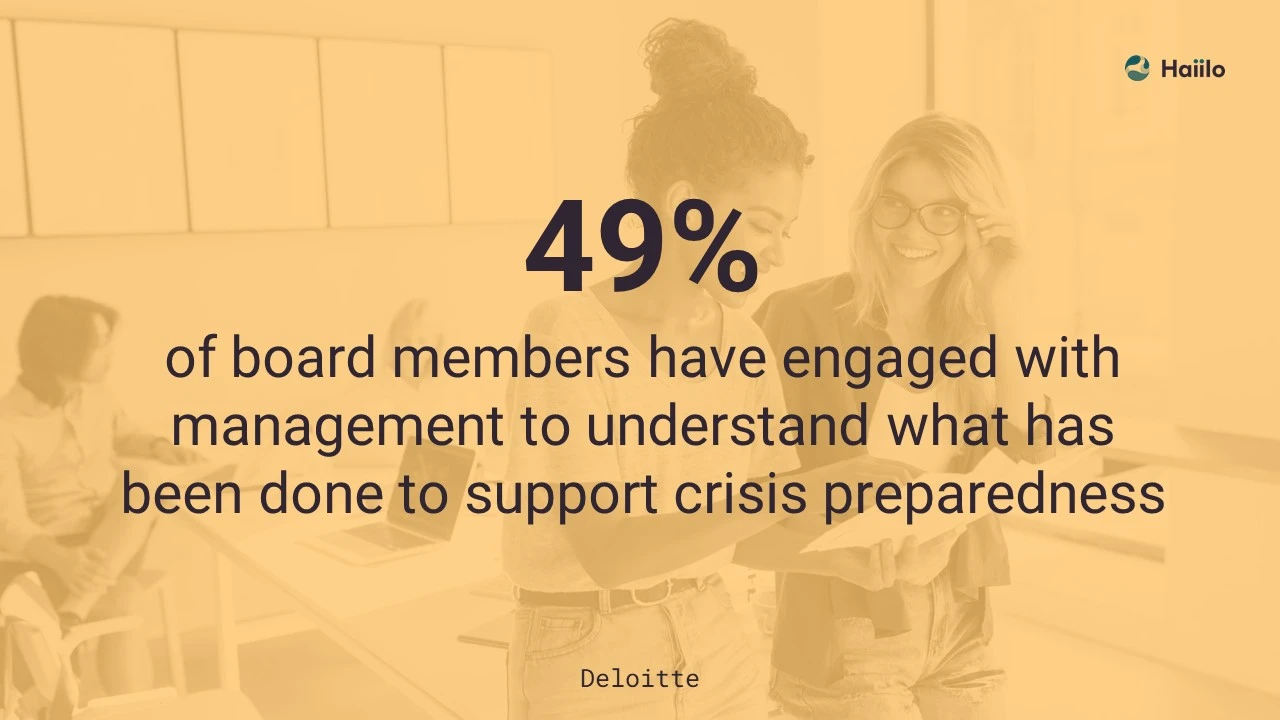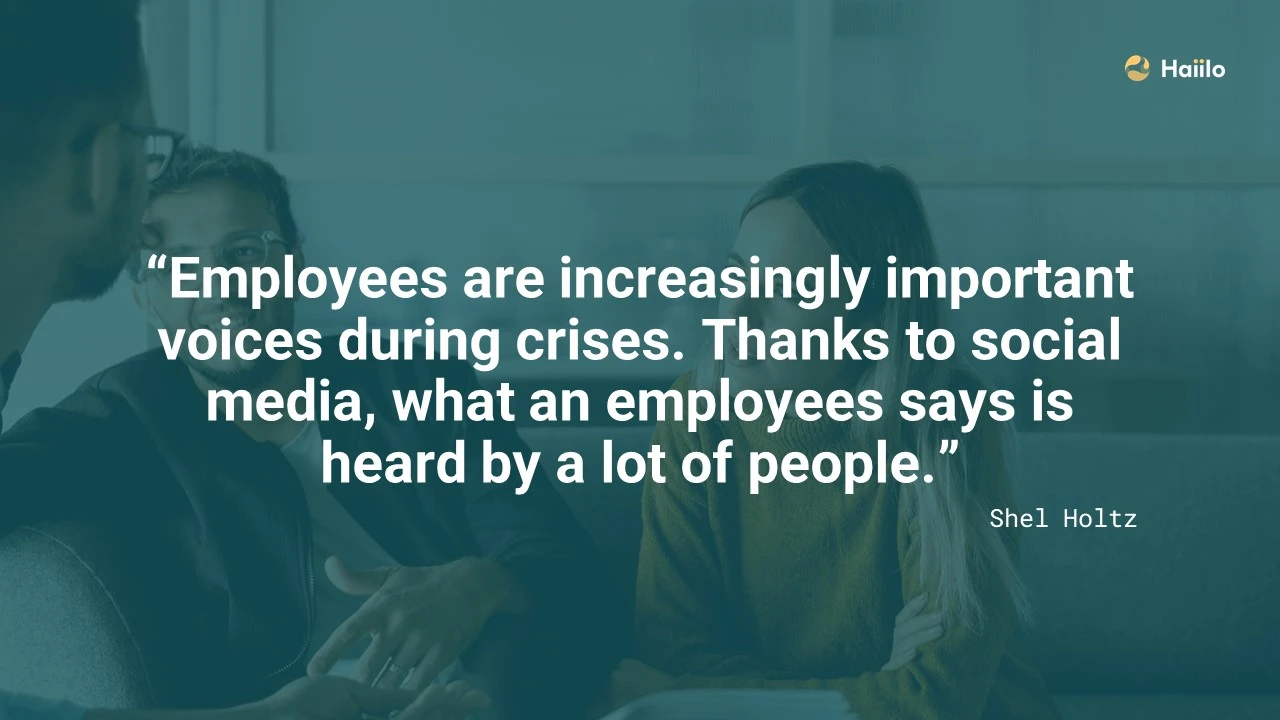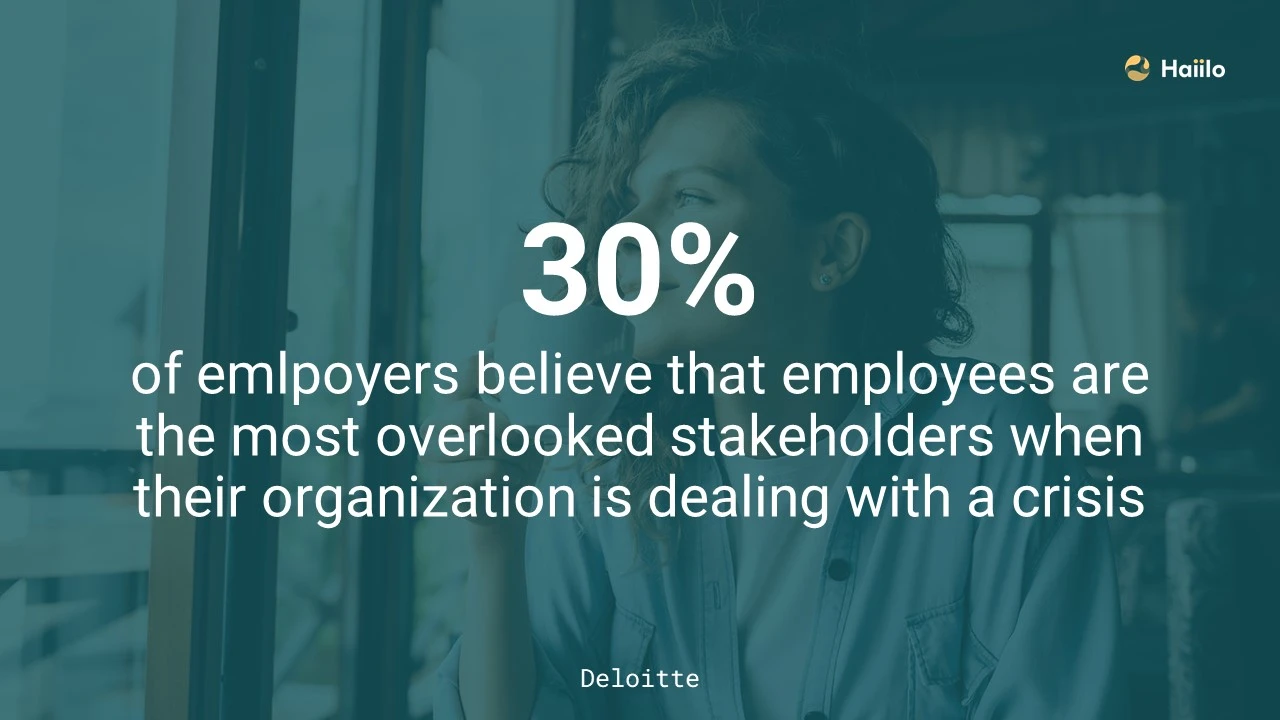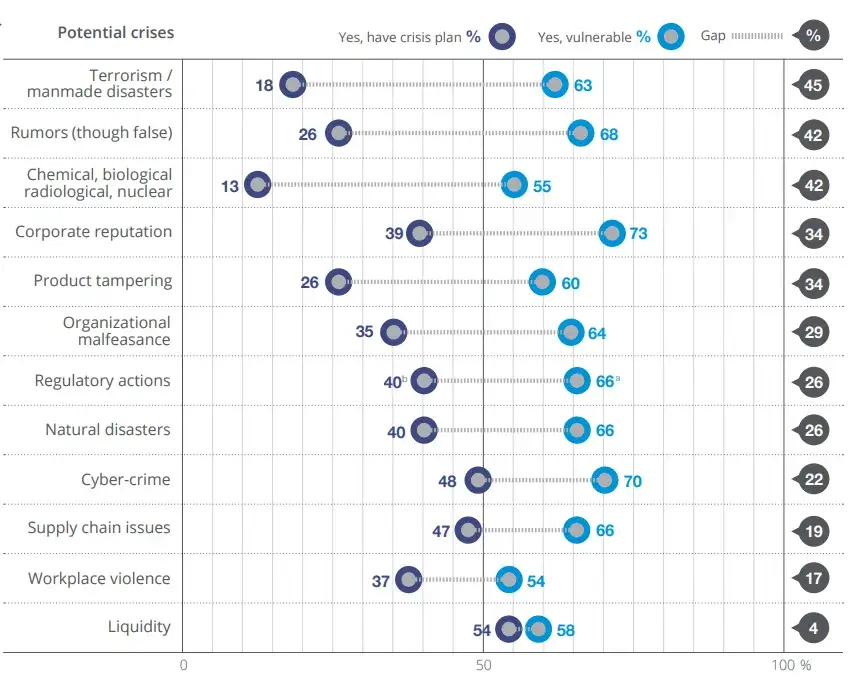According to research on crisis communication, 47% of employers say that they have the capabilities or processes they would need to meet a crisis with the best possible outcome.
In addition, fewer than half of the total respondents say they have a “playbook” that sets out some of the options, actions, and decisions that may be required for specific, defined crisis scenarios.
📚Check out our article about Communication Strategies and How to Create Your Own.
Organizations that are trying to excel in their crisis management strategies need to address crisis with a more strategic approach.

Source: Deloitte
Therefore, we have written a guide that can help you optimize the way your organization handles crisis in the workplace.
What is Crisis Communication?
The main goal of every workplace crisis communication strategy is to enable seamless communication during crisis within an organization.
Messages used in crisis communication are meant to provide employees with the knowledge needed to make the right decisions during crisis and emergencies. Some of the common situations in which crisis communication is used include product recalls, data breaches, workplace injuries, bankruptcies, and other workplace situations such as sexual harassment.
To communicate crisis, leadership, internal communications and PR teams use employee communication tools to share updates and important company information during the crisis.
When thinking about the new challenges of handling crisis in digital workplaces, communication and executives charged with managing risk worry about spotting unprecedented situations and preparing their workplace.
Having sophisticated technology that monitors all channels of communication in the workplace is the first step in preventing catastrophe!
A crisis is stressful, but crisis communication doesn’t have to be! Let us show you how
5 Pillars of Successful Crisis Communication
There are certain rules crisis communicators should follow when speaking to their audience. These pillars eliminate the challenges organizations face when managing the crisis and communicating their strategy to employees and customers.

- Keep it simple – keep your crisis communications simple and easy-to-consume for everyone. When communicating in times of crisis, simplicity is best, and clarity is king. Ensure your message has a clear objective, and make it relevant and tailored to your target audience.
- Make it credible – Do you and your crisis communication team have credibility? Does your audience trust you? This is where it’s important to make sure that your delivery matches your message. Ensure you always present the evidence to support your message.
- Show empathy – showing empathy during crisis is crucial. The best way to show empathy to people affected by the crisis is by active listening and encouraging bottom-up feedback.
- Show competency – In times of crisis and change, highlighting your organization’s competency is important. Do you have the skills, knowledge, resources, and people to follow through and get things done? If so, remind your people that you are ready to handle unprecedented situations.
- Make it share-worthy – make your crisis communications visual and share-worthy. Word-of-mouth will help spread your message and reach a wider audience. Encourage your people to share the message internally and externally where relevant.
Setting up an Effective Crisis Communication Strategy
Even though many employers are aware of the importance of crisis communication, not many of them have a clear plan and strategy about what to do when a crisis happens.
Let’s go over the 13-step crisis management strategy.
📹 Before we move forward, check out our Masterclass about hot to set internal communication goals for your organization.
1. Create a crisis communication plan
Like any other workplace strategy, crisis communication needs a well-set plan and objectives. Without the proper plan, crisis communicators are less likely to follow the company rules and they may not be able to align employees with the overall strategy.
The crisis communication plan should also identify all the possible situations in which crisis communication is needed.
More about how to develop a successful strategy in the following steps.
2. Appoint your crisis communication team and spokesperson
Choosing and appointing the right people who will be in your crisis communication team is extremely important. Here, it is important to understand that even though the company’s CEO is an important figure, people from other departments such as managers, HR professionals, operations, internal communications, and PR departments should be involved in the strategy.
The person you assign as the spokesperson should be trained and experienced in how to handle crisis and emergency, communicate well with the employees, react on a timely basis and always be ready to answer employees’ specific questions.
3. Train communicators and help them develop good communication skills
Same as for many other positions in the organizations, appropriate training and skill development are essential to help a crisis spokesperson succeed in their job.
Besides training available to crisis communication professionals, it is extremely important that these people have good communication skills.
Therefore, proper communication skills are the most valuable skills a spokesperson can possess as they have a significant impact on how to gain employees’ attention, connect with employees, build trust in the workplace and make employees work towards the same goals.
4. Bring the board members on board
Board members should be well aware of the company’s crisis management strategy and they should be aligned with the rest of the leaders and crisis communicators.
However, research on crisis management by Deloitte proves that only 49% of board members have engaged with management to understand what has been done to support crisis preparedness. Only half say that board members and management have specific discussions about crisis prevention.

📚 Also, read about the top leadership skills that make great leaders.
5. Close the gap between “feeling ready” vs. “being ready”
The same research by Deloitte shows that there is a significant gap between people feeling and really being ready to cope with and handle crisis situations.
The research shows that more than 76% of board members believe their companies would respond effectively if a crisis struck tomorrow. Yet only 49% of board members say their companies engage in monitoring internal communications to detect trouble ahead.
In addition, only 32% say their companies engage in crisis simulations or training.

📚 As change management is crucial for successful crisis management, also read about the top 5 change management models.
6. Understand your audiences
Same as in any communication strategy such as marketing communications, workplace crisis communicators need to have a very good understanding of their audience.
In most situations, there will be multiple audiences a spokesperson would have to communicate and connect to. Therefore, the ability to segment those audiences properly and adjust the approach and messages to them is crucial for successful crisis communication.
Also, depending on the type of crisis, not every employee may be the right audience to communicate with. In any situation, however, the message needs to be delivered in a timely manner, it needs to be clear and easy to understand.
Timely communication is crucial because the worst thing that can happen is for your employees to hear about the crisis from a source different from their own employer.
However, many employers still don’t have the right communication tools to really understand and manage their multigenerational workforce.
7. Deliver messages that matter to your defined audiences
Once you manage to define your audiences, adjusting the internal crisis communication content is the next important step.
Remember that not every employee should receive every message during an emergency as this approach just slows down employees’ response time by overwhelming them with irrelevant information.
Ideally, your internal communication solution should be able to target specific individuals and departments to ensure the most pertinent information gets to those who need it most.
Luckily, there are mobile-first employee communication solutions such as Haiilo that enable employers to deliver real-time communication to relevant audiences in any location. Members of your leadership, internal communication, HR, or crisis management teams can instantaneously deliver relevant information updating appropriate team members as needed.

Employers that manage to adopt these best crisis communication practices are more likely to equip people with important information, optimize employee experience, streamline emergency response, protect people, keep physical and digital assets safe, and minimize lost productivity and revenues.
8. Implement a two-way crisis communication
It is very important to understand that, during a crisis, employees are a valuable asset because they are the voice of the company and they can be your strongest advocates.

For that reason, crisis communication should not go one-way. Crisis communication should enable employees to join the two-way conversations, raise their concerns and ask questions.
However, many employers base their crisis communication on employee newsletters and similar ways of communicating that don’t enable employees to share their voice and thoughts.
9. Communicate in real-time using the right communication channels
Earlier, we talked about the negative impacts of information overload on the workplace.
In companies that communicate mainly through emails or even instant messaging apps, it is not uncommon for employees to miss out on important company updates. During the crisis, employers can not afford this to happen.

Therefore, employers need to make sure to use the right internal communication channels that will be considered as their main source of information during crisis times.
10. Give special attention to your non-wired employees
Emails can be very inefficient in providing crisis communications to non-wired employees, remote employees, or employees who may be away from their desks. In addition, they are very ineffective during a power failure.
Therefore, the most effective way to communicate during an emergency or crisis is via mobile technology, which goes wherever your employees go.
Haiilo’s mobile-first approach to crisis communication is one of the primary reasons why companies across the world use Haiilo as their main employee communication channel.

11. Make sure your messages are accurate and consistent
During crisis, companies are under the microscope of public and media. When communicating with employees, it is important to deliver the right information even if that sometimes means answering with “I don’t know”.
Giving wrong information to the employees can cause the spread of misinformation which can significantly hurt employees’ trust and have a negative impact on employee motivation and engagement.
Messages delivered to employees have to be consistent no matter which communication channel you use and whether you are communicating with internal or external stakeholders.
Some companies also tend to neglect or ignore the crisis. However, if you don’t comment on the situation, be sure that someone else will.
Therefore, consistent and transparent communication is a must-have during a crisis.
12. Monitor communication and employees’ behaviors and react in a timely manner
Unfortunately, many employers don’t have insights into their employee engagement with the crisis-related content delivered to them. This causes high levels of uncertainty and fear that employees haven’t even got or read the critical updates.
Not with Haiilo!
Haiilo enables crisis communicators to get a real-time view of the status and employee engagement with the internal content. As we understand the importance of measuring the effectiveness and outcomes of internal communications efforts, we have developed a tool that enables communicators to better understand the ROI of their internal communication efforts.
13. Perform a post-crisis analysis
When the crisis is over, employers need to ask themselves: “What did we learn from this?”. Even though these situations are not comfortable to anyone, they should serve as a good learning curve. The 5 questions every employer should address after the crisis include:
- What did we do right?
- What did we do wrong?
- How to improve crisis communication next time?
- What are the critical crisis communication elements that have a big and direct impact on how the crisis was handled?
- How can we better prepare our crisis communications team?
Also, check what crisis experts have to say about building an effective crisis management strategy.
15 Communication Challenges in Crisis Response
Creating an effective crisis management plan can be among the hardest tasks the internal and crisis communications team has to perform. Not only because the risks are so high, but because crisis is often hard to predict and plan for, and 2020 is the year where we all learned that.
Therefore, making communication more flexible, agile, and interdepartmental is crucial. However, this often not so easy to achieve, which is why communication challenges decision-makers experience during the response stage of crisis management can be significant.
Let’s take a look at some of the challenges that both communicators and employees face during crisis.
- Too much irrelevant information (information overload)
- Too little information
- Infrequent information
- No contact data
- Unpredictable situations
- Lack of visibility and transparency in the workplace
- Lack of support from leadership
- Lack of situation awareness from the audience
- Wrong communication paths and channels
- Inability to access important information and documents from any location
- Wrong form and content of communication
- Inability to communicate via smartphones
- The inability for employees to provide feedback
- The inability for managers to stay connected with their teams
- Sending instant push notifications to employees’ smartphones
Here is another great research on the challenges with communication in response to crisis.
Situations in Which Crisis Communication Plans are Crucial
Earlier, we mentioned a few crisis situations that can happen in the workplace. However, the list is much longer than that. Also, the less ready employers feel or are for a certain crisis situation, the more vulnerable they feel like the image from Deloitte’s research shows.
In other words, the lack of preparedness for different crisis situations results in a bigger, thus called, vulnerability gap.

Here are some of the workplace situations when crisis communication is extremely important:
- Terrorism/manmade disasters
- Rumors
- Chemical, biological radiological crises
- Corporate reputation
- Product tempering
- Organizational malfeasance
- Regulatory actions
- Natural disasters
- Cyber-crime
- Supply chain issues
- Workplace violence
- Liquidity
Also check this great CEO’s Guide to Preparing for the Next Crisis.
The Importance of Crisis Communication
When it comes to crisis in the workplace, research shows that the areas that make employers most vulnerable are corporate reputation (73 percent), cyber-crime (70 percent), and rumors (68 percent). Two-thirds (66 percent) named supply chain issues, regulatory action, and natural disasters as vulnerabilities as well.
Therefore proper crisis communication in the workplace can help you:
- Protect your employees and other stakeholders during a crisis
- Build trust in the workplace
- Prevent the spread of misinformation in the workplace
- Prevent panic and help employees feel secure
- Prevent the threat a crisis may have on the organization’s strategic objectives, reputation, and viability.
- Align employees with the overall crisis management strategy and enable them to work towards the same goals
- Align the internal and external messages
- Keep customers loyal
- Keep the reputation of being an attractive employer
Optimize Your Crisis Communication Strategy with the Right Technology
Haiilo is a leading employee communication solution used by organizations across the world. Not only does Haiilo help organizations improve employee productivity, experience, and engagement, but it also enables employers to handle crisis in a more efficient way by making sure that employees across the organization stay well informed and connected.

As learned earlier, proper employee communication is one of the most important prerequisites for managing crisis.
With Haiilo, employers are enabled to create specific audiences based on various criteria, they can engage employees in two-way conversations, create personalized employee news feeds, and measure the engagement employees have with the internal content delivered to them.
Haiilo’s mobile-first approach and content relevance guarantee much higher user adoption and consumption rates compared to some other communication channels such as emails. This is critical as employers can not afford employees to miss out on important information during crisis.
Are you ready to master your crisis communication efforts and strategy? If so, schedule a Haiilo demo to see how it can help you with that!










